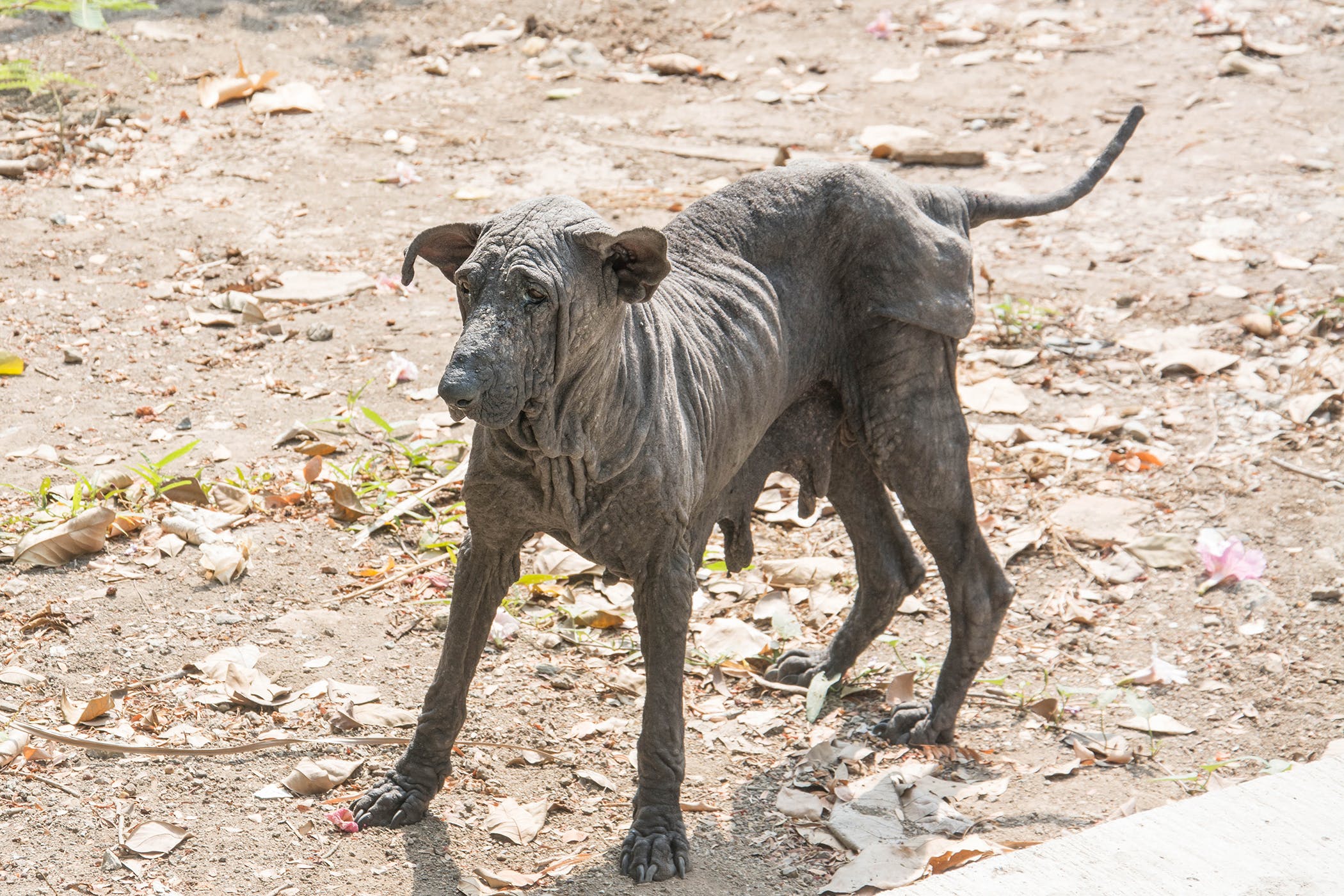BLACK SKIN DISEASE (BSD) IN DOGS
COMPILED & EDITED BY-DR. AMIT ,CANINE SPECIALIST,GOA
Black skin disease is characterized by skin darkening and hair loss in canines. It is a progressive condition that’s related to hormones. When dogs have black skin disease, they experience symmetrical hair loss on their bodies. Other names for the disease include both “alopecia X” and “adrenal sex hormone imbalance.” When dogs have black skin disease, they experience patterned baldness. Their guard hairs typically drop before the rest. This hair loss exposes undercoats that are simultaneously dry and reminiscent of cotton in texture. Once the guard hairs come off, significant amounts of the rest of the hair drop in a symmetrical manner. The balding skin takes on a much darker appearance. Dogs with particularly severe cases of black skin disease sometimes lose most of their hair, with bits remaining solely on their paws and heads. Hair loss (alopecia) accompanied by darkening of the skin (hyperpigmentation) is often termed “black skin disease”. Other names applied to this condition include wooly coat, coat funk, pseudo-Cushing’s syndrome, and severe hair loss syndrome. In Pomeranians, this condition is suspected to be an X-linked inherited disorder since many more males than females are affected, and research is being carried out to identify a linked gene marker so that dogs in this breed can potentially be tested for the condition. Other breeds with increased prevalence of black skin disease include the Alaskan malamute, keeshond, poodle, dachshund, chow chow, Samoyed and American water spaniel.
Symptoms of Black Skin Disease in Dogs
Black skin disease is a condition that typically progresses slowly. If you notice a thinning of your dog’s hair or obvious hair loss, you will need to contact your veterinarian for an assessment. Signs of black skin disease include:
- Gradual loss of hair’s color and lushness
- Gradual and symmetrical loss of the guard hairs
- Increasingly cottony undercoat that is dry
- Symmetrical baldness
- Hyper-pigmentation of the skin
- Change in appetite and/or thirst
Causes of Black Skin Disease in Dogs
It is unclear what causes black skin disease to develop; it has been linked to hormonal imbalances, allergies, obesity and genetic factors. Most dogs will begin showing signs after puberty occurs and most cases reported are males.
Dogs that are diagnosed with black skin disease should not be bred. This can be problematic for breeders since male dogs are commonly used for breeding for the first time around a year old. Symptoms of black skin disease do not appear until between the ages of 2 years and 3 years, that male could have already produced a number of puppies before he exhibited any symptoms of black skin disease. Responsible breeders will thoroughly research their breeding dogs’ bloodlines prior to breeding.
Dogs of certain breeds are particularly susceptible to black skin disease, specifically those with plush coats. These breeds include keeshonds, Pomeranians, miniature poodles, toy poodles, American Eskimos, Siberian huskies, malamutes, Norwegian elkhounds, Samoyeds and chow chows. Black skin disease is prevalent in Nordic breed dogs. Note that while some types of dogs are especially vulnerable to this condition, it’s been observed in all canine breeds.
Diagnosis of Black Skin Disease in Dogs
There are no actual tests that can be done to diagnose black skin disease. Instead, diagnosis is made through a series of tests that eliminate other possible causes for the symptoms that have presented. Your veterinarian will perform a physical examination and order blood tests, a biochemistry panel, urinalysis and fecal examine to rule out thyroid disease, Cushing’s disease and intestinal parasites. A skin scraping may also be performed to determine that there is not a fungal or bacterial skin infection. A biopsy can be helpful in directing your veterinarian to this diagnosis.
Treatment of Black Skin Disease in Dogs
Black skin disease is purely cosmetic, meaning that it does not cause your dog irritation or pain. Your dog will be much more susceptible to the cold and to the sun. They will easily sunburn and could also be more vulnerable to frostbite. Treatments for black skin disease will differ per dog; there is no set protocol that will work for every dog. The overall goal for treatments is to have your dog re-grow their coat and prevent a recurrence of hair loss.
Spaying or neutering your dog should be the first step in their treatment. Since black skin disease is believed to be genetic, you do not want to breed your dog and possibly produce puppies that will develop the condition. Sterilization may also aid in re-growing the coat because the hormonal changes that will take place after the procedure. The coat re-growth is not always permanent.
Another possible treatment will be oral melatonin therapy. Melatonin is a natural supplement that can be given to improve coat re-growth within 6-8 weeks. Melatonin has not been approved by the FDA, but can be found over-the-counter in tablet form. There are side effects to melatonin such as drowsiness and sedation. You should always consult with your veterinarian prior to beginning any treatments.
Hormone therapy such as methyltestosterone can be implemented. Blood work must be performed periodically to monitor the level of the hormone, as methyltestosterone can be damaging to your dog’s liver over time. Hormone therapy can cause increased aggression in your dog, as well.
Other treatments for black skin disease that your veterinarian may choose to implement include prescribing prednisone, cimetidine, ketoconazole, anipryl or leuprolide. These treatments are someitmes used to try and re-start the growth cycle of hair follicles.
REFERENCE-ON REQUEST
IMAGE COURTESY-https://wagwalking.com/
https://wagwalking.com/condition/black-skin-disease



